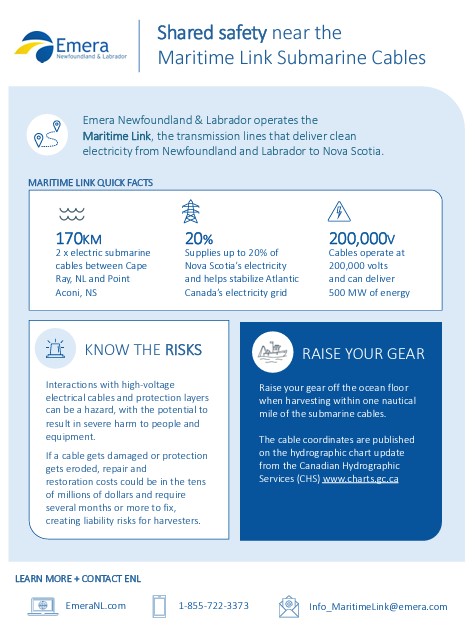Safety & Environment
Operating safely and sustainably
We are committed to working safely and in ways that help protect the places we work and live. We have been focused on safety and environmental protection since the very beginning of the Maritime Link. During the construction phase, we met early and often with Indigenous communities, fishers and other community members to learn and to share information about safety and the environment. We continue to speak with these groups, to conduct regular safety drills with first responders, to lead safety-focused conversations with members of the public and to ensure there is appropriate safety signage around our assets.
Learn more about our safety and environmental commitments
Shared Marine Safety

We maintain a rigorous safety program to ensure the safe operation of the Maritime Link. The cables are buried in the sea floor and protected by berms. Changes in the undersea environment can lead to variation in the depths of trenches and berms.
Although the power cables are buried in the sea floor and intended to be protected, conditions in the Cabot Strait may result in portions of the cables becoming exposed. Contact with the high-voltage submarine cables and their protection system can be dangerous, disruptive and difficult to repair. For fishers, it can lead to harm to people and equipment.
Since 2017, the locations of the cables have been published on the hydrographic chart update from the Canadian Hydrographic Services. Fisheries and Oceans Canada’s Groundfish General Licence Conditions and Schedule 34 prohibit the use of bottom-trawling mobile gear within one nautical mile on both sides of the Maritime Link subsea cables.
We appreciate the important contribution of fisheries to Atlantic Canada’s communities and economy. We have a shared commitment to keeping our oceans safe for everyone.
Safety Management
Our Safety Management System (SMS) is informed by the International Standards Organization (ISO) 45001 standard. It provides a comprehensive platform for the governance of safety policies and programs, including the consistent application of corporate standards, compliance requirements and continual improvement.
Environmental Management
Our Environmental Management System (EMS) identifies and manages the environmental commitments and risks associated with our operations. Our EMS is based on international standards. It includes reference to relevant legislative and regulatory requirements, defined environmental targets, environmental monitoring, corrective action approaches and auditing activities to ensure compliance with the environmental policy. Environmental regulatory requirements such as the Environmental Management Plan (EMP) and the Environmental Protection Plans (EPPs) are developed under the EMS umbrella.
Environmental Assessment Report
On June 21, 2013, the Maritime Link project received Environmental Assessment release from the Canadian Environmental Assessment Agency, Nova Scotia's Department of Environment, and Newfoundland and Labrador's Department of Environment and Conservation.


